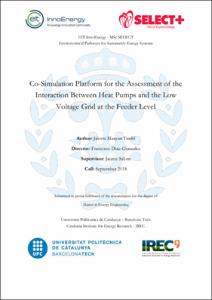Mostra el registre d'ítem simple
Large Scale Heat Pump Installation Effects on the Interaction between Buildings and the Electric Grid
| dc.contributor | Díaz González, Francisco |
| dc.contributor.author | Maayan Tardif, Jalomi |
| dc.contributor.other | Universitat Politècnica de Catalunya. Departament d'Enginyeria Elèctrica |
| dc.date.accessioned | 2018-10-30T09:45:34Z |
| dc.date.available | 2018-10-30T09:45:34Z |
| dc.date.issued | 2018-09-17 |
| dc.identifier.uri | http://hdl.handle.net/2117/123215 |
| dc.description.abstract | In the past years Heat Pumps (HP s ) have experienced significant growth rates , and this electrification of residential heating could contribute to decarbonizing the energy sector in many countries, as well as provide flexibility potential to the grid. However, the widespread use of HPs, substituting fuel boilers, could lead to grid c ongestion problems, particularly at the low voltage (LV) level since the distribution equipment may not be adequately dimensioned. This thesis will present a co - simulation environment which uses the Functional Mock - up Interface (FMI) standard within a Python framework. Two case studies are presented, one in Spain and one in Sweden, representing the s outhern and n orthern European c limates . Two newly developed variable speed air - to - water and air - to - air HP model s , which account for the degradation of performance due to cycling conditions , interact dynamic ally with residential building models implemented in TRNSYS, with stochastic three minutes time - step demand profiles . The building models are each wrapped into a Functio nal - Mock - up Unit (FMU) and the corresponding electric loads are evaluated in the CIGRE LV benchmark grid, with the Python based power - flow analysis tool PandaPower. The design and validation of a complex network, which integrates controllable loads such as HPs, Distributed Energy Sources (DERs), and active power electronics, becomes challenging and experimental data is not easily obtained for such large scales. Therefore, simulation - based approaches are possibly an appropriate tool to support the developmen t of innovative grids, however such systems require integrated models to represent all key element, namely energy markets, grid equipment, communication and control devices, and each connected building. The co - simulation framework presented in this thesis allows for the coordination and synchronization of multiple specialized tools for each element with high resolution domestic load profiles, which capture short term power spikes that are otherwise attenuated. In addition to the general feasibility of the p roposed framework for simulation - based assessment of complex grids, the capacity of an urban and a rural LV grid to accommodate increasing penetration rates of HPs is evaluated. To this end, a set of key performance indicators that can be useful to the Dis tribution System Operator (DSO) are used: the minimum and maximum observed nodal voltages, the voltage - drop across the feeder, and the peak transformer loading. The results show that the sensitivity of the LV feeder to a high level of integration of domest ic HPs is dependent on geographical location , the HP technology, and the energy density along the feeder. This work confirms that rural feeders are more at risk of breaching the minimum acceptable voltage levels, due to the long distances between delivery points. In the Swedish case the transformer is overloaded, while in Spain it remains within acceptable levels . Finally, HP s can increase or decrease the transformer load, depending on which conventional heating technology was previously commonly used in th e region under investigation |
| dc.language.iso | eng |
| dc.publisher | Universitat Politècnica de Catalunya |
| dc.rights.uri | http://creativecommons.org/licenses/by-nc-nd/3.0/es/ |
| dc.subject | Àrees temàtiques de la UPC::Energies |
| dc.subject.lcsh | Heat pumps |
| dc.subject.lcsh | Dwellings--Energy consumption |
| dc.title | Large Scale Heat Pump Installation Effects on the Interaction between Buildings and the Electric Grid |
| dc.type | Master thesis |
| dc.subject.lemac | Bombes de calor |
| dc.subject.lemac | Habitatges -- Consum d'energia |
| dc.identifier.slug | ETSEIB-240.135830 |
| dc.rights.access | Open Access |
| dc.date.updated | 2018-10-05T05:25:23Z |
| dc.audience.educationlevel | Màster |
| dc.audience.mediator | Escola Tècnica Superior d'Enginyeria Industrial de Barcelona |
| dc.audience.degree | MÀSTER UNIVERSITARI EN ENGINYERIA DE L'ENERGIA (Pla 2013) |
Fitxers d'aquest items
Aquest ítem apareix a les col·leccions següents
-
Màster universitari en Enginyeria de l'Energia (Pla 2013) [669]
Màster vinculat al programa KIC InnoEnergy


